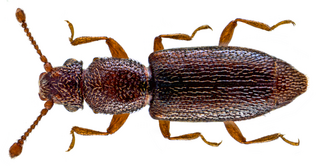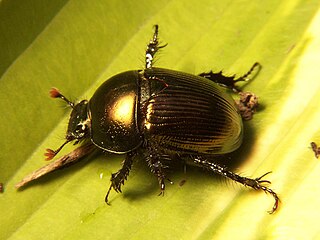Bolbocerosoma pusillum is a species of beetle in the family Bolboceratidae. It is found in North America.

Bolbocerosoma is a genus of earth-boring scarab beetles in the family Bolboceratidae. There are about 13 described species in Bolbocerosoma.

Bolboceratinae is a subfamily of earth-boring scarab beetles in the family Geotrupidae. There are about 8 genera and at least 40 described species in Bolboceratinae.
Euparixia is a genus of aphodiine dung beetles in the family Scarabaeidae. There are about 10 described species in Euparixia.
Bolbocerosoma farctum, the fancy dung beetle, is a species of earth-boring scarab beetle in the family Geotrupidae. It is found in North America.

Bolbocerosoma tumefactum is a species of earth-boring scarab beetle in the family Geotrupidae. It is found in North America.
Bolbocerosoma lepidissimum is a species of earth-boring scarab beetle in the family Geotrupidae. It is found in North America.
Bolbocerosoma confusum is a species of earth-boring scarab beetle in the family Geotrupidae. It is found in North America.
Bolbocerosoma elongatum is a species of earth-boring scarab beetle in the family Geotrupidae. It is found in North America.
Hyperaspis paludicola, the swamp lady beetle, is a species of lady beetle in the family Coccinellidae. It is found in North America.
Phausis rhombica is a species of firefly in the family of beetles known as Lampyridae. It is found in North America.
Mulsantina hudsonica, the hudsonian lady beetle, is a species of lady beetle in the family Coccinellidae. It is found in North America.

Monotoma longicollis is a species of root-eating beetle in the family Monotomidae. It is found in Africa, Australia, Europe & Northern Asia, North America, and Southern Asia.
Epilachna tredecimnotata, the southern squash lady beetle, is a species of plant-eating lady beetle in the family Coccinellidae. It is found in the Caribbean, Central America, North America, and South America.
Dichelonyx elongatula is a species of scarab beetle in the family Scarabaeidae. It is found in North America.
Eurypogon californicus is a species of soft-bodied plant beetle in the family Artematopodidae. It is found in North America.
Agrilus angelicus, known generally as the oak twig girdler or Pacific oak twig girdler, is a species of metallic wood-boring beetle in the family Buprestidae. It is found in North America.
Bolbocerosoma hamatum is a species of earth-boring scarab beetle in the family Geotrupidae. It is found in North America.
Phyllophaga bruneri, the Cuban May beetle, is a species of scarab beetle in the family Scarabaeidae. It is found in the Caribbean and North America.
Bolbocerosoma ritcheri is a species of earth-boring scarab beetle in the family Geotrupidae. It is found in North America.




